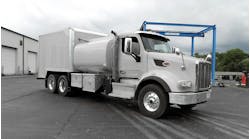Loading and unloading racks at oil production facilities may be excluded from certain requirements of the Spill Prevention, Control, and Countermeasure (SPCC) rule, according to a proposal from the Environmental Protection Agency (EPA) announced October 1.
EPA also is proposing amendments to the SPCC rule to increase clarity and tailor certain requirements as they apply to facilities handling animal fats and vegetable oils.
The SPCC rule applies to owners or operators of oil production facilities that drill, produce, gather, store, process, transfer, use, or consume oil or oil products above applicable thresholds and could reasonably be expected to discharge oil to waters of the United States. Facilities are subject to the SPCC rule if they meet at least one of these capacity thresholds: aboveground oil storage capacity (counting only containers with a capacity of 55 gallons or greater), greater than 1,320 gallons or completely buried oil storage capacity (counting only containers with a capacity of 55 gallons or greater), or greater than 42,000 gallons.
The loading/unloading rack exclusion proposal is in revisions EPA is proposing to certain regulatory requirements for oil storage facilities subject to the SPCC rule. However, EPA said nothing in the proposed rule removes any regulatory requirement for owners or operators of facilities in operation before Aug 16, 2002, to develop, implement, and maintain an SPCC plan in accordance with the SPCC regulations then in effect.
In the proposal related to oil production facilities, EPA is:
-
Modifying the definition of “production facility”, consistent with the proposed amendments to the definition of “facility.”
-
Extending the timeframe by which a new oil production facility must prepare and implement an SPCC plan.
-
Exempting flow-through process vessels at oil production facilities from the sized secondary containment requirements, while maintaining general secondary containment requirements and requiring additional oil spill prevention measures.
-
Exempting flowlines and intra-facility gathering lines at oil production facilities from all secondary containment requirements, while establishing more specific oil spill prevention measures.
-
Clarifying the definition of “permanently closed” as it applies to an oil production facility.
EPA also is taking comment on approaches that could be used to establish alternative criteria for an oil production facility to be eligible to self-certify an SPCC plan as a qualified facility, and approaches to address produced water containers at oil production facilities.
The current EPA information is provided online by accessing www.epa.gov/oilspill/spcc_oct07.htm. An EPA helpline is available by phoning 800-424-9346.








